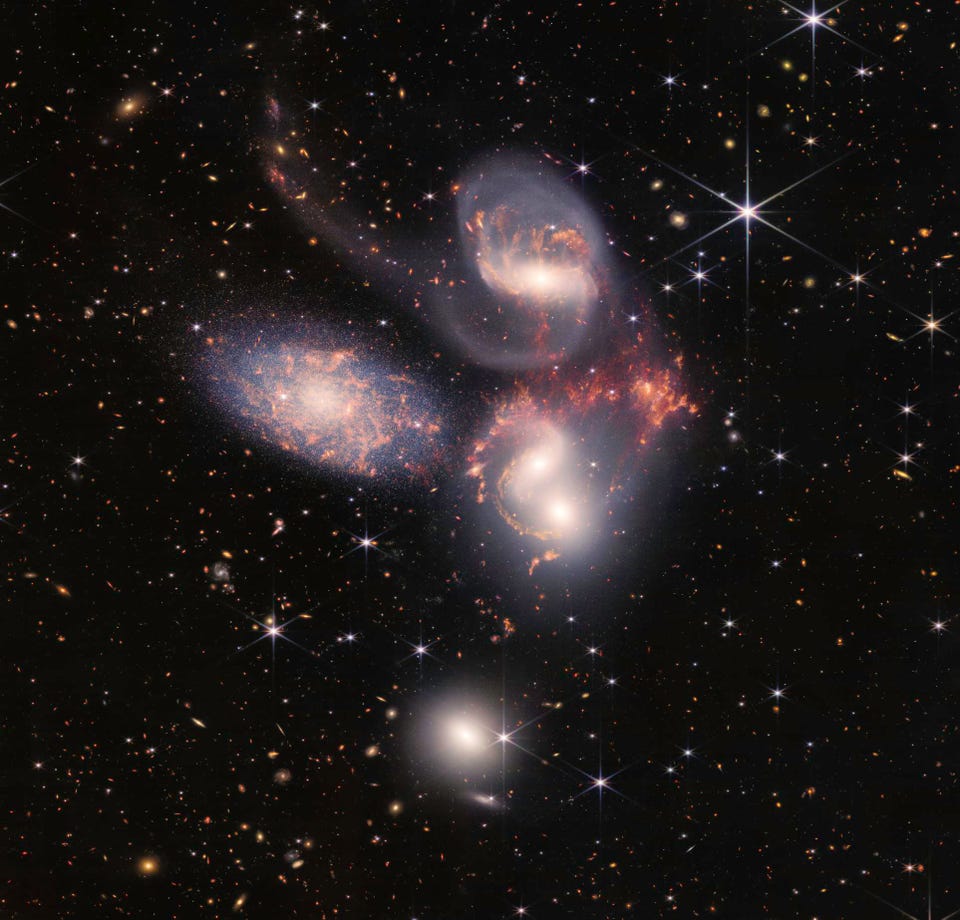NASA’S Webb Telescope Is Close To Detecting ‘Cosmic Dawn’


IN SPACE – JULY 12: In this handout photo provided by NASA, NASA’s James Webb Space Telescope reveals Stephans Quintet, a visual grouping of five galaxies, in a new light on July 12, 2022 in space. This enormous mosaic is Webb’s largest image to date, covering about one-fifth of the Moons diameter. It contains over 150 million pixels and is constructed from almost 1,000 separate image files. The information from Webb provides new insights into how galactic interactions may have driven galaxy evolution in the early universe.
Getty Images
NASA’S James Webb Space Telescope is close to detecting the universe’s cosmic dawn when the universe was first bathed in starlight. Or so says astronomer Richard Ellis, a renowned professor of astrophysics at University College London, and author of the recent book, “When Galaxies Were Born: The Quest for Cosmic Dawn.”
During a career that has spanned six decades, Ellis has helped usher in a new era of galactic astronomy. All total, he has spent nearly 800 nights at some of the best ground-based optical observatories the world has to offer. And in the process, he’s seen the lookback times for the onset of galaxy formation continually pushed back to only a few hundred million years after the big bang.
Webb is already forcing a sea change in our view of the early cosmos.
In the first six months, we’ve explored hitherto completely uncharted periods of cosmic history, Ellis told me by phone from London. Secondly, these early objects seem to be qualitatively different from the galaxies that we see, at later times, he says. These early galaxies are compact, and super-luminous and forming stars at least 10 times faster than our present Milky Way Galaxy, says Ellis. Probably the most important result so far is that we’re finding these early galaxies that are brighter than expected and ferociously forming stars, he says.
The marked brightness of these early galaxies likely stems from the fact that they contain very few heavy elements, says Ellis. Therefore, he expects that their stars would generally be more massive, shine more brightly and burn out very quickly, perhaps in as few as five to ten million years.
But curiously, the galaxies are only two to three thousand light years across. Compare that with the diameter of our own Milky Way Galaxy which spans some 100,000 light years.

When Galaxies Were Born
Princeton University Press
Ellis and I first met some twenty years ago while he was a professor at Caltech in Pasadena. At the time, he was simply thrilled that astronomers were detecting galaxies that were forming some 800 million years after the big bang. Today that number has been more than cut in half.
Because Webb is a 6.5-meter infrared telescope with an onboard spectrograph, it’s able to find and characterize galaxies further back in time than NASA’s Hubble Space Telescope.
“We’re now witnessing galaxies only 250 years to 350 million years after the Big Bang,” said Ellis. “That is shocking.”
As you go back to these early times, the light from those early galaxies has been stretched into the infrared region, where Hubble didn’t have coverage, says Ellis. So, in just six months, from the first science results from Webb, it’s clear that people are finding galaxies beyond the horizon that was set by Hubble, he says.
There are two key methods for determining distance to these far-flung galaxies. One is by using optical photometry to measure the galaxies’ color. In general, galaxies that are at cosmological distances appear redder due to the light being stretched into the infrared part of the electromagnetic spectrum. But a more precise method of nailing a given galaxy’s distance can be had by using ground- or space-based spectroscopy.
The first step is to measure a target galaxy’s atomic emission and absorption chemical spectra using a spectrograph. Then, in turn, its approximate distance (or red shift) can be calculated by comparing known laboratory reference spectra with the redshifted atomic lines being observed in the galaxy.

Ellis at the whiteboard in his former Caltech office.
Richard Ellis
Does cosmic dawn have a smoking gun?
“A widely discussed test for a first-generation galaxy, unpolluted by any nucleosynthesis, would be to recover a spectrum devoid of emission lines other than those of hydrogen and helium,” Ellis writes in his book, “When Galaxies Were Born.”
Ellis has likened the search for pristine early galaxies to searching for a proverbial ‘needle in a haystack.’
So, statistically, we may have to look at the chemical composition of galaxies at different times, says Ellis. And as we go back, they should have fewer and fewer heavy elements, he says.
Although it may be extremely difficult to prove we have found a galaxy with absolutely no heavy elements, a spectrum of a galaxy that has no signature of oxygen, or carbon, or nitrogen would be a telltale signal, says Ellis. If no such galaxy is found, he and colleagues may simply use statistical analysis to infer the precise timeframe that such, now theoretical, pristine galaxies saw their first starlight.
How does studying these earliest galaxies further our understanding of the cosmos as a whole?
Knowing how quickly these objects formed relates to how structure grows in the universe, says Ellis. To the person in the street, cosmic dawn is the birth of starlight, the birth of chemistry and all the elements that we see in everyday life, he says.
“It’s really the beginning of our origin which ends up in life,” Ellis told me. “Understanding how quickly that happened is the last missing piece in cosmic history.”
